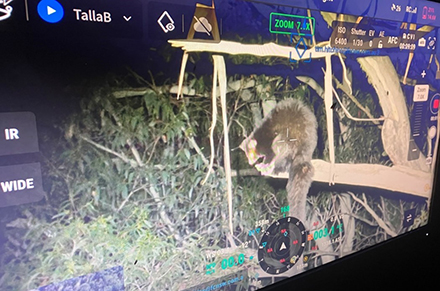
Photo of Greater Glider identified with thermal drone – glider is visible with 2 small red heat spots.
Forestry Corporation of NSW is trialing new ways of searching for Greater Glider dens in the wake of proposed introduction of survey requirements for this species tabled by the Environment Protection Authority. Source: Timberbiz
The ruleset governing native forestry in NSW, the Coastal Integrated Forestry Operations Approval (CIFOA) outlines the protections for threatened species at a landscape level. These have been implemented for the past 5 years without any concerns being raised. However, in recent months Forestry Corporation has received stop work orders in two south coast forests related to searching for Greater Glider dens.
General Manager Hardwood Forests, Daniel Tuan, said that since the EPA raised concerns in Tallaganda State Forest in August this year, Forestry Corporation had been working with the EPA to understand the new desired survey requirements for dens and trialling new methods to achieve this.
“In the past we used spotlight transect sample surveys to search for Greater Gliders themselves to understand the density of glider populations in forests. These were conducted in the hours after sunset along tracks and trails to ensure it was safe for the people walking in the bush after dark and dens were seldom sighted.”
“It was thought that thermal UAVs might offer a better alternative to finding dens, so we have been trialling different technologies and methods in these two forests.”
Across Tallaganda and Flat Rock State Forests eight nights of targeted Greater Glider surveys have been undertaken involving over 30 UAV flights.
The UAV flights must meet CASA regulations and require pilots to be CASA certified and qualified to fly drones with ‘extended visual line of sight’ and ‘night operations’.
“This is a brand-new proposed survey approach so we are trialling everything from the type of UAV fitted with equipment like thermal imaging cameras and spotlights, the duration of the flight, the speed, height, intensity of sampling and data recording requirements, Mr Tuan said.
“All of this has to be done when it is relatively cool to allow for thermal cameras to detect animals, so the survey flights are being conducted either late at night or very early morning. The efficacy of these surveys and the different equipment and techniques is simply not known at this stage.
“In Tallaganda we already knew Greater Gliders were present as we have been undertaking a monitoring program there for several years which has detected hundreds of records. In these latest trials with UAVs we found over 80 individual Greater Gliders but the technology did not allow us to identify any dens. In Flat Rock, which is a coastal forest less suitable for Greater Gliders, we found 2 individual Greater Gliders but again no dens.”
The UAV surveys have been conducted using a combination of new UAVs purchased by Forestry Corporation and a number of expert UAV specialist companies who have extensive experience in land and forest management applications.
“We have more trials planned across a series of other forests over the next month to see if we can find a method that can reliably identify dens across the landscape,” Mr Tuan said.
“Protecting the habitat of threatened species is always a priority for us and something that the CIFOA ruleset is predicated on.
“With the trials of UAVs are proving challenging, we have also proposed alternate precautionary measures to the EPA across a broad range of forests we know Gliders use to augment the protections that are already in the ruleset.”
Under the existing CIFOA ruleset, planning for harvesting operations in these two forests included over 300 kilometres of detailed habitat assessment traverse with over 6000 hollow bearing trees and over 2000 giant trees marked for protection. Hollow bearing trees will often be used as dens for arboreal mammals and birds but can only be recorded as a ‘den’ when an animal is seen entering or emerging from the hollow.








